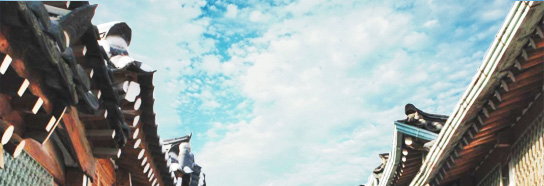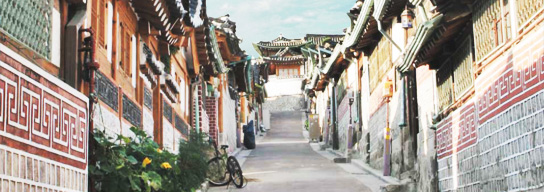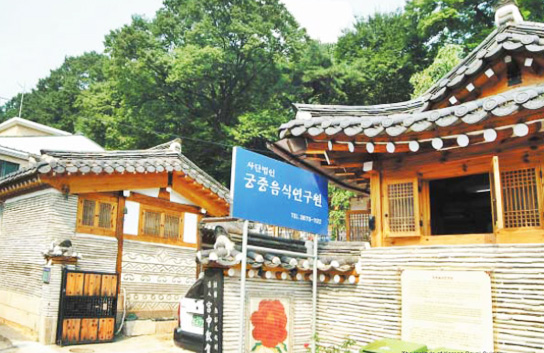 | |
 | |
 | |
| A stroll through the alleyways of Bukchon, the city’s historic residential quarter, offers precious respite from the frenetic pace of urban life and a fascinating, somewhat romanticized view of Old Seoul. Captivating views over the curved tiled roofs of the traditional Korean houses, or hanok, and the pretty patterned stone walls lining the narrow streets are perhaps Bukchon’s most famous feature, a stark contrast to the shiny titanium towers thrusting from the business and commercial districts downtown. History buffs, architecture fans, connoisseurs of culture and most of all, the curious, are certain to be charmed. | |
| Between the Two Palaces | |
 Bukchon
is wedged between Gyeongbokgung Palace and Changdeokgung Palace in the north of
the city, and this was the village to where high-ranking officials of the Joseon
dynasty would catch the last palanquin home after a long day at court spent
plotting schemes and taking bribes. Subsequently, the area is steeped history
and intrigue. Bukchon
is wedged between Gyeongbokgung Palace and Changdeokgung Palace in the north of
the city, and this was the village to where high-ranking officials of the Joseon
dynasty would catch the last palanquin home after a long day at court spent
plotting schemes and taking bribes. Subsequently, the area is steeped history
and intrigue. The challenge to planning a walk round Bukchon is deciding where to start. The village covers a great chunk of acreage, encompassing five dong or neighborhoods, including those of Anguk-dong, Gahoe-dong, Jae-dong, Gye-dong and Samcheong-dong. And there’s a lot to see and do: museums, art galleries, workshops, fine dining, famous artisans who do wonderful things with embroidery, silkand arrow heads, and, course, the unique landscape. | |
 | |
| On
this particular foray, first stop is the Bukchon Cultural Centre, housed in a
refurbished hanok, where you can join free tours and pickup maps and other info,
mostly in Korean. Even lacking the expertise of an official guide, it’s fun to
poke around the grounds, picturing oneself as a high-ranking Joseon official —
the delicate latticed windows are especially delightful. Set off east along Bukchon 1-gil and passing several real estate agencies that suggest a buoyant local property market, the curved roofs and wooded slopes of Changdeokgung Palace become visible. Making a left, on the corner is an interesting compound set behind an imposing wooden doorway. This is the site of the former royal police station dating back to the last tumultuous days of the Joseon era. It's now used by followers of Wonbulgyo, or Won Buddhism, a relatively new indigenous Korean religion that combines traditional Buddhist thought with Christian social reform. I was shown around by one of the sect’s elders, a stern woman in her 60s dressed all in black who stressed the asceticism of the group’s beliefs. No Buddha figures, for example. Yet the garden, and especially the decorative walls surrounding the complex, are far from austere and well worth some snapshots. → Click here for more on Gyeongbokgung Palace → Click here for more on Changdeokgung Palace → Click here for more on Guest houses in Bukchon | |
| Seoul Meets Hogwarts | |
| Heading north, parallel to the palace, tour guide Cho Young Hee was leading a party of three. The road we were on, he said, covered a stream that the government planned to excavate to create another Cheonggyecheon, the canal opened in 2005 that runs through Seoul north of the Hangang river. Very pleasant, I thought, once the dust settles and the trucks depart. Another such stream would be a refreshing antidote to Seoul’s exhaust-thick streets. | |
| |
| A Sea of Korean Tile | |
 From
the school, heading southwest into 11 Gahoe-dong, you can slip down any alley
and have a good nose around the hanok whose roofs decorate the skyline. The
renovated ones are stunning, especially those adorned with climbing pot plants.
I particularly like the granite stonework, the black and white rectangular
patterned tiles, and the sturdy doorways. These houses retain an air of the
archaic, but at the same time, occupy a fiercely modern world: you can’t fail to
spot the state-of-the-art security devices and intercoms. You’ll also see some
hanok in desperate need of fresh timber and a lickof paint, a reminder that
without modernization, many of these houses would be uninhabitable. From
the school, heading southwest into 11 Gahoe-dong, you can slip down any alley
and have a good nose around the hanok whose roofs decorate the skyline. The
renovated ones are stunning, especially those adorned with climbing pot plants.
I particularly like the granite stonework, the black and white rectangular
patterned tiles, and the sturdy doorways. These houses retain an air of the
archaic, but at the same time, occupy a fiercely modern world: you can’t fail to
spot the state-of-the-art security devices and intercoms. You’ll also see some
hanok in desperate need of fresh timber and a lickof paint, a reminder that
without modernization, many of these houses would be uninhabitable. | |
| |
| Where the Hanok Reigns Supreme | |
 Continuing
west across the road that drives up towards the Bukhansan National Park towards
31 Gahoe-dong, is the setting which is described to have the best views over the
village. To be honest, there’s a lot of construction going on and swanky SUVs
clogging the tight paths were a pain, but once at the top of the hill, you won't
be disappointed. There are no 24 hour convenience stores, no visible overhead
cables, no museums and commercial buildings - just hanok and pigeons hopping
across the sloping roof tiles. Very tranquil, with an atmosphere not unlike a
ghost town. Continuing
west across the road that drives up towards the Bukhansan National Park towards
31 Gahoe-dong, is the setting which is described to have the best views over the
village. To be honest, there’s a lot of construction going on and swanky SUVs
clogging the tight paths were a pain, but once at the top of the hill, you won't
be disappointed. There are no 24 hour convenience stores, no visible overhead
cables, no museums and commercial buildings - just hanok and pigeons hopping
across the sloping roof tiles. Very tranquil, with an atmosphere not unlike a
ghost town. | |
| Jeongdok Library, Gwanghyewon | |
 From
31 Gahoe-dong, go southwards to the Jeongdok Library to contemplate the sight of
Jongchinbu, the pavilion where kings would discuss matters of state with their
personal advisers, some of whom no doubt lived in Gahoe-dong. It’s also
worthwhile to wander around the Seoul Museum of Historical Materials of
Education and its exhibits of old textbooks, school uniforms and pins - it’s a
lot more interesting than it sounds. From
31 Gahoe-dong, go southwards to the Jeongdok Library to contemplate the sight of
Jongchinbu, the pavilion where kings would discuss matters of state with their
personal advisers, some of whom no doubt lived in Gahoe-dong. It’s also
worthwhile to wander around the Seoul Museum of Historical Materials of
Education and its exhibits of old textbooks, school uniforms and pins - it’s a
lot more interesting than it sounds. To cap off this good three hour walk, checkout the site of Gwanghyewon, Korea’s first modern hospital, and where the Constitutional Court now sits. Gwanghyewon was built in 1885 at the behest of King Gojong after the American medical missionary Dr. Horace Allen saved the life of a member of the royal family. At the back is a well-kept garden, home to a very rare 600 year-old lacebark pine. Arthritic-looking, pale and propped up on stilts, the tree is a virtual soul mate for this traveler. It’s time to rest your feet on a nearby bench. As it started to drizzle, I couldn’t help but wonder, if this tree could talk, what stories it could tell. | |
| Written by Michael Gibb / Photos by Ryu Seunghoo
The article courtesy of Seoul Magazine |
Following its miraculous development over the last 50 years, Korea is now a modernized vibrant nation that still maintains its traditional culture. Learn all about this fascinating country.
Ranking 1 Blue-bigbang
2. 2AM / I Wonder If You Hurt Like Me
2012년 3월 14일 수요일
Living History in Bukchon
피드 구독하기:
댓글 (Atom)
3.BigBang / FANTASTIC BABY
4.miss A / Touch
5.T-ara / Lovey-Dovey
6.FTISLAND / Fiercely
7~ 10
7.Ailee / Heaven
8.John Park / Falling
9.K.WILL / I Need You
10,Trouble Maker / Trouble Maker
 “Even
lacking the expertise of an official guide, it’s fun to poke around the grounds,
picturing oneself as a high-ranking Joseon official - the delicate latticed
windows are especially delightful.”
“Even
lacking the expertise of an official guide, it’s fun to poke around the grounds,
picturing oneself as a high-ranking Joseon official - the delicate latticed
windows are especially delightful.” “There
are no 24 hour convenience stores, no visible overhead cables, no museums and
commercial buildings — just hano and pigeons hopping across the sloping roof
tiles.”
“There
are no 24 hour convenience stores, no visible overhead cables, no museums and
commercial buildings — just hano and pigeons hopping across the sloping roof
tiles.”
댓글 없음:
댓글 쓰기